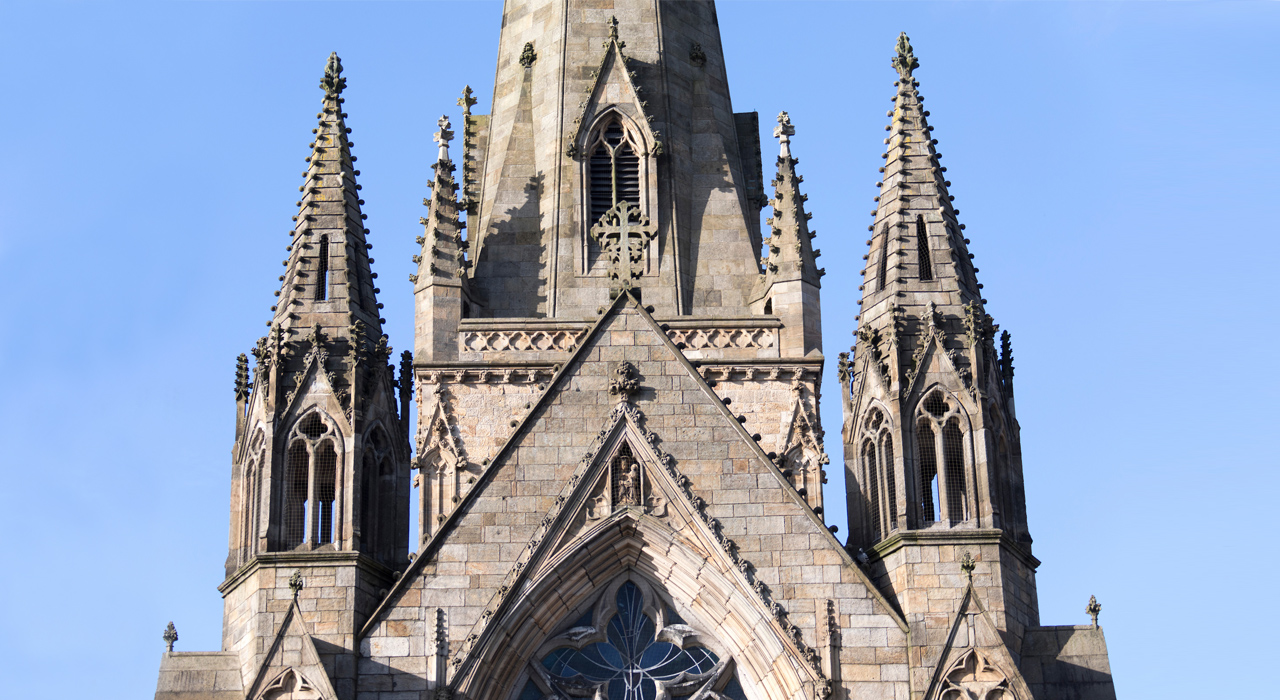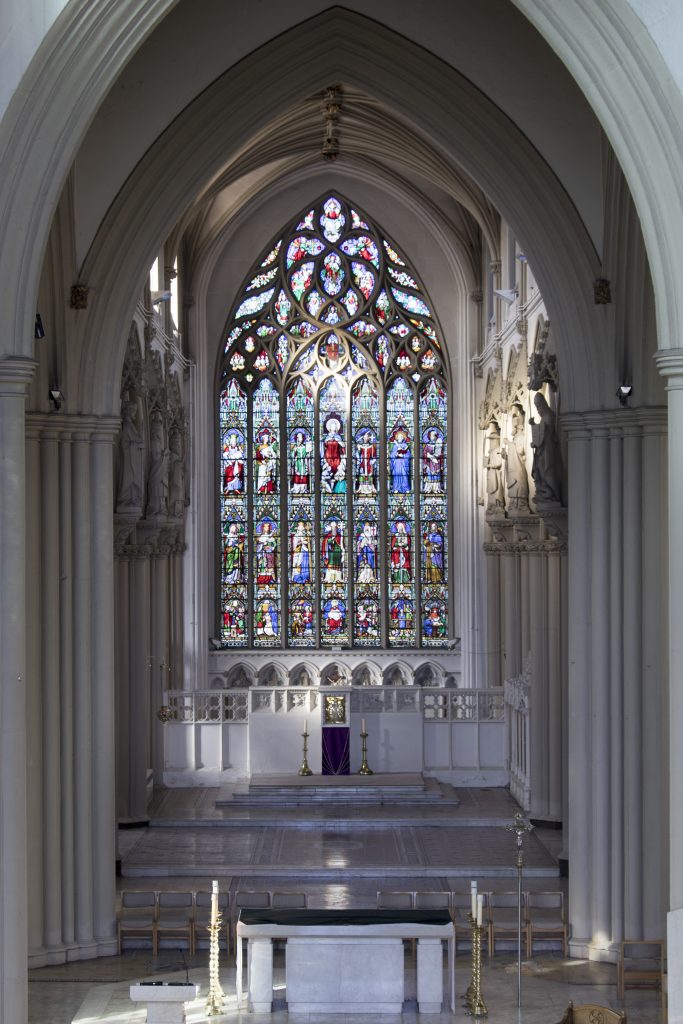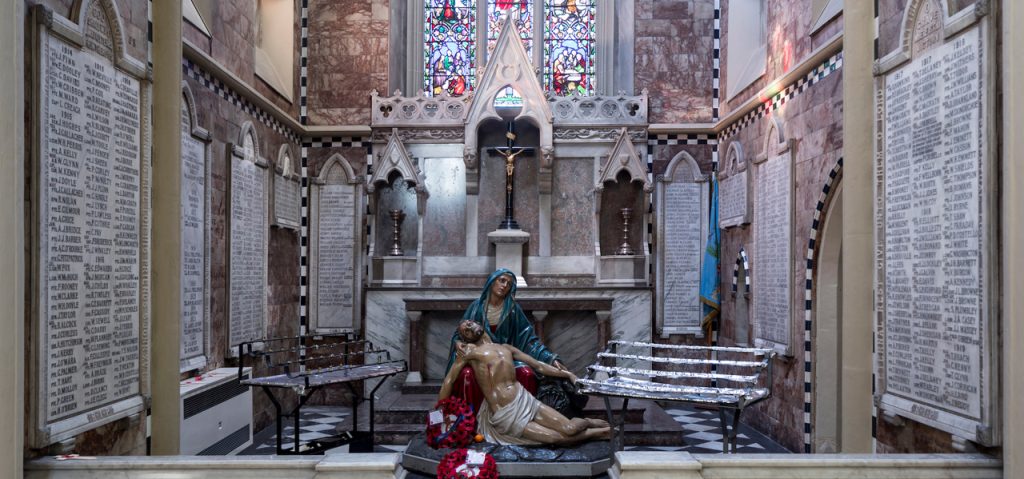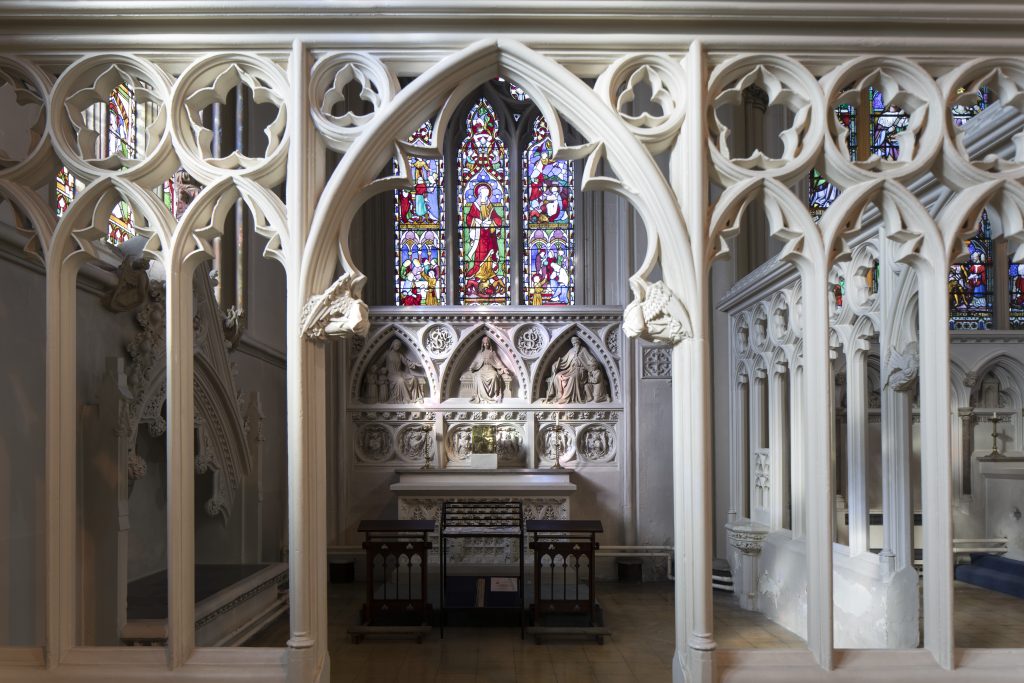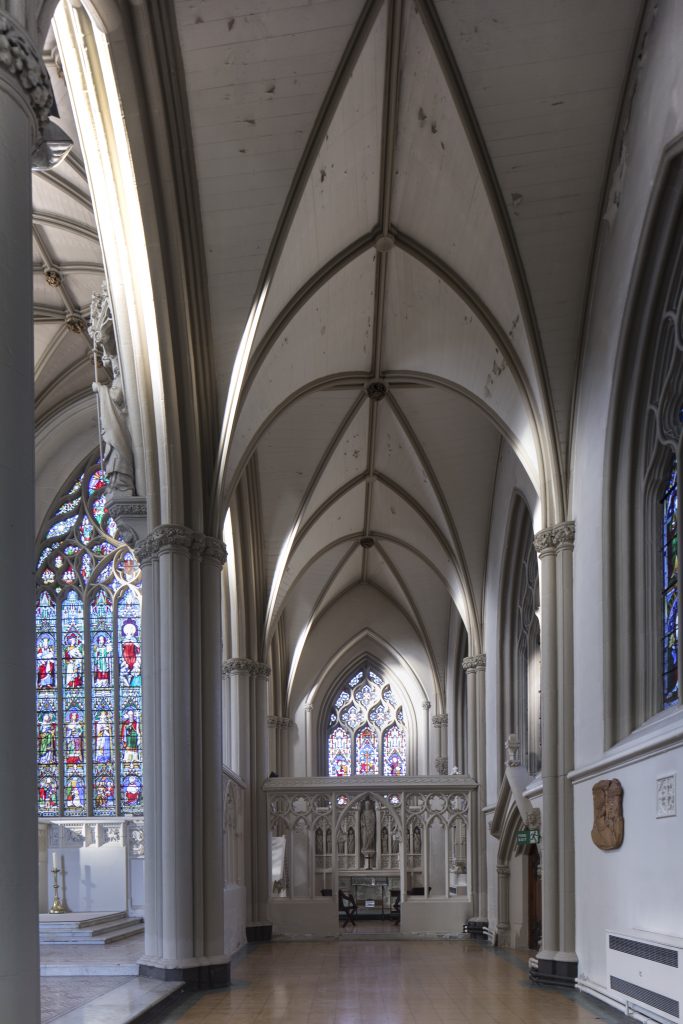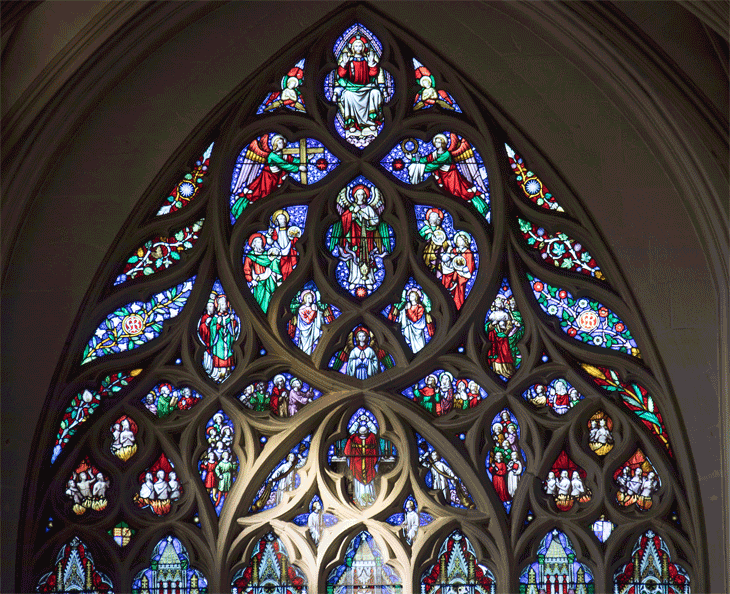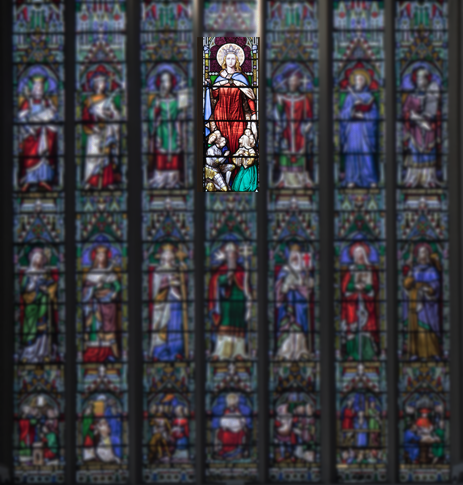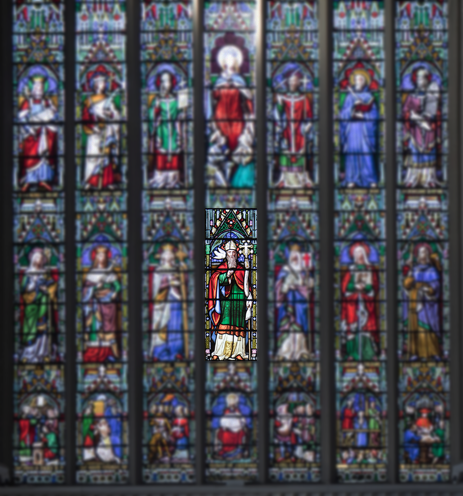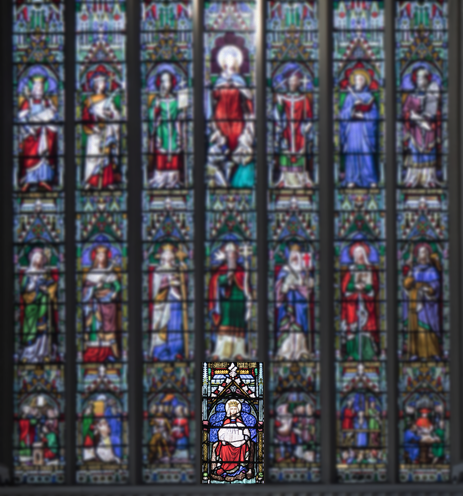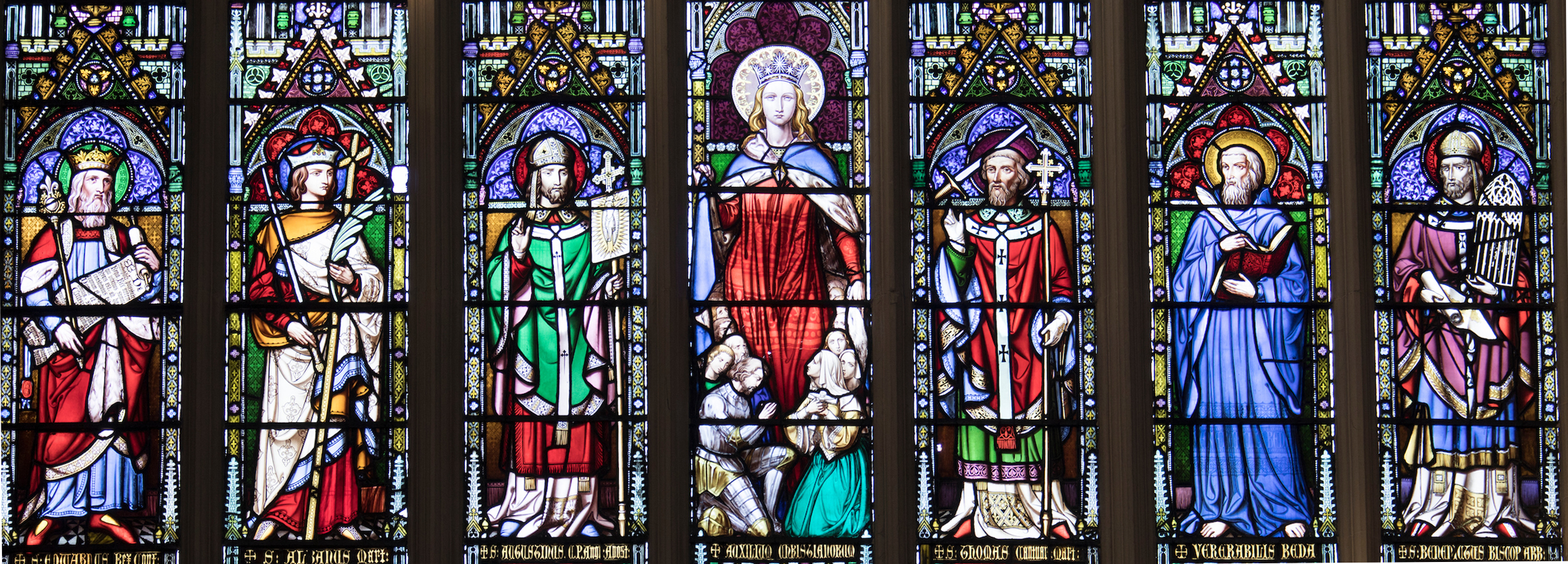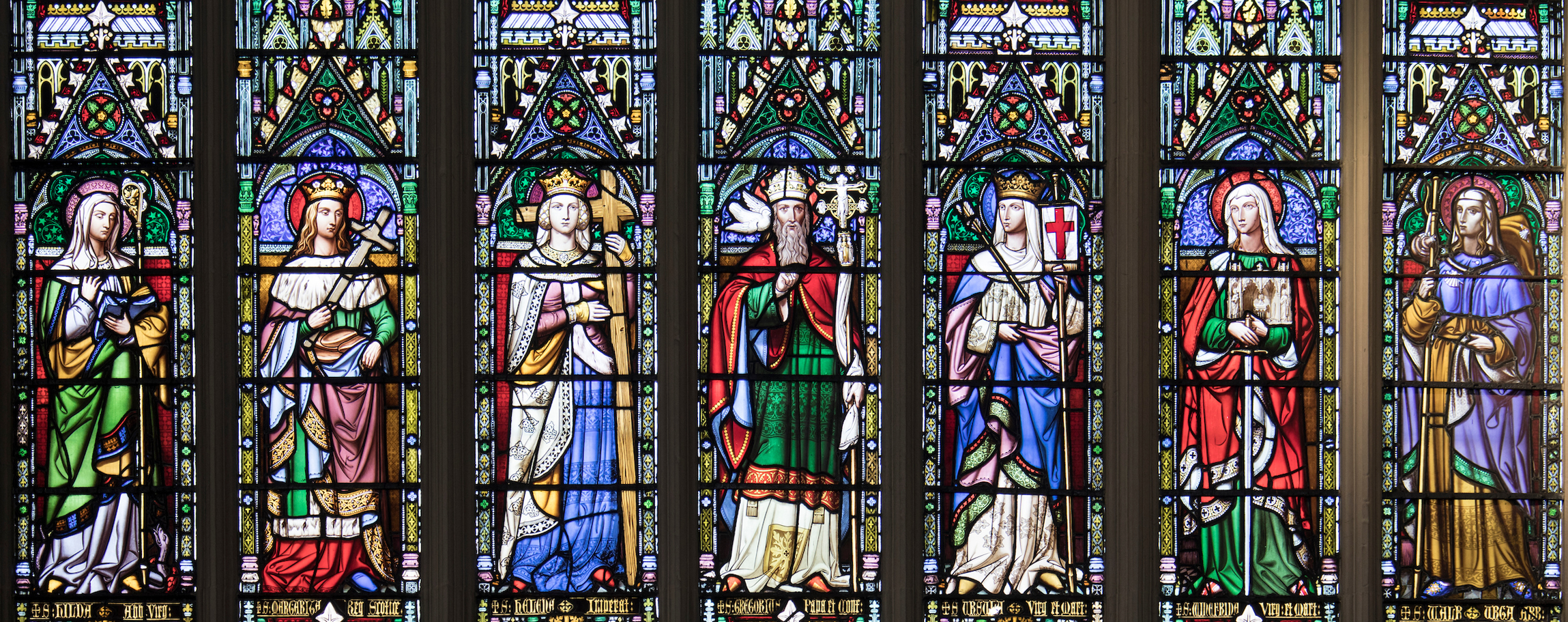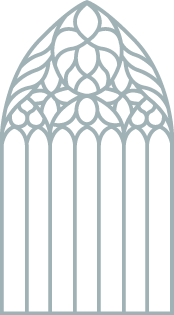From medieval times, when the people were largely illiterate, artists have designed stained and painted glass windows which are not only works of art but also visual story books. Our cathedrals’ pride and joy, the great East window is such a history in glass. It recounts no less a story than that of the glory of the Catholic Church in England from the conversion of Ethelbert, King of Kent, by the first archbishop of Canterbury, St Augustine in AD 597 up to the restoration of the Catholic Hierarchy in 1850.
The work of William Wailes of Newcastle-upon-Tyne, the window is 40ft in height with seven lights (individual windows) beneath flamboyant tracery. Wailes’s use of rich bright colours make the window easy to study even on the dullest day bringing vivid life to the story he is telling.
Find out more about the many glories of our cathedral using the drop-downs below.
On Whit Thursday, 1844, Bishop James Sharples, Coadjutor Bishop of the Lancashire Vicariate, laid the foundation stone of the new church before approximately 6,000 people.
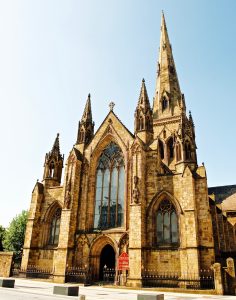
Four years later on 9th August 1848, the Church of St John the Evangelist was opened. The architect was Matthew Ellison Hadfield (1812–1885) of Weightman and Hadfield based in Sheffield, and the construction work was undertaken by Benjamin Hollins of Manchester. Hadfield’s design for St. John’s, the first cruciform (cross-shaped) Catholic church to be built in England since the Reformation, was closely modelled on a number of noted medieval churches. The “west” (actually south) front and nave are based on those of Howden Minster; the choir and sanctuary are closely modelled on Selby Abbey; the tower and spire are copied from the parish church of St Mary Magdalene in Newark-on-Trent, Nottinghamshire; the groined vaulted ceiling of the choir was inspired by that in the church of St Jacques in Liege, Belgium; and the statuary in niches on the columns of the choir are in the are in the manner of those of the Apostles in Cologne Cathedral.
The modern high altar is in the centre of the crossing sanctuary, installed in the 1971-72 reordering, the altar is plain with a large central supporting slab and narrower slabs at either side; it is constructed of Bottichino marble. The matching ambo and Baptismal font located within the sanctuary were added in the 1985-88 reordering.
The cathedra is an original piece of furniture though not originally the chair used as the It is freestanding and of carved oak with horizontal x-frame construction and has an ‘IHS’ monogram and rosebud detailing. It is housed between carved marble armrests with blind tracery details; these are remnants of the altar rails installed around 1960, set within a Bottichino marble back. The celebrant and deacons chairs are also original; the original cathedra is located in the sacristy.
The only remnants of the original high altar are four carved reliefs of the emblems of the four Evangelists, either side of the tabernacle; Lane and Lewis of Birmingham carved them.
Six statues in the spandrels of the choir arcades represent the four Latin Doctors of the Church, the Patron Saint of England and A king of England. On the north side (west to east) they are: St Edward the Confessor, St Augustine of Hippo, and Pope St Gregory the Great. On the south side (west to east) they are: St George, St Ambrose of Milan, and St Jerome. Also by Lane and Lewis they were originally polychromed.
The floor is mosaic tesserae, originally by Minton. This was extensively restored, probably by Ludwig Oppenheimer Ltd. of Old Trafford, after the Second World War following fire damage. Details include Our Lady of Mount Carmel, the Lamb of God and St John the Evangelist, and, the coat of arms of Pope Pius XII.
The Holy Rosary altar located in the west wall of the north transept was formerly located in the west wall of the south transept until the construction of the confessional block in 1951. Installed in 1886, the altar and reredos are of painted carved stone with painted panels depicting Our Lady of the Rosary and numerous saints representing the dedications of the parishes of the diocese at that time. The decoration is probably by J. A. Pippet.
The Bishop Sharples Memorial lies in the north wall of the north transept. It consists of a carved stone effigy of Bishop Sharples holding a model of the cathedral, and lying within a canopied sepulchre, it is likely to have been carved by Lane and Lewis of Birmingham.
The original Rood Cross is located on the north wall of the north transept. It is of carved oak with a painted corpus and gold-leaf decoration, and there are symbols of the four Evangelists at the terminals; it was the work of Cesar De Jonghe of Bruges. Carved fleur-de-lys and scroll details were removed when the crucifix was relocated here in the 1980s.
The south transept houses the Blessed Sacrament Chapel, which dates from 1884 and was designed by Peter Paul Pugin (1851-1904). The carved marble altar and reredos is the work of Robert Lockwood Boulton (c1832-1905), they depict Eucharistic emblems and the Pelican in Her Piety.
The altar contains an effigy and relics of St Aurelius brought back from Rome by Bishop (later Cardinal) Herbert Vaughan (1832-1903) the second Bishop of Salford. The painted scenes on the panelling are by Joseph Aloysius Pippet (1841-1903); they depict the Joyful, Sorrowful and Glorious Mysteries of the Rosary. The Blessed Sacrament is now reserved in the tabernacle where the original high altar was located.
No pre-1884 images of the south transept have been found so it is uncertain how this appeared originally. An iron screen was installed when it became the Blessed Sacrament chapel and was removed in the 1980s re-ordering.
Built at the same time as the rest of the church this chapel originally served as the Blessed Sacrament chapel. In 1884 when the new, larger Blessed Sacrament Chapel was constructed in the south transept this became the Calvary Chapel. In 1923 the chapel was opened as the WWI Memorial chapel.
The windows depict Christ with the Holy Eucharist in the centre with scenes of sacrifice from the Scriptures; the side windows depict angels incensing. All appear to be by William Wailes c1855.
The ceiling panels were installed when the chapel served as the Calvary chapel from 1884-1920, and originally formed a backdrop to the pieta, they depict the instruments of Our Lord’s Passion.
The pieta dates from the 1930s and was originally located in the WWI Memorial chapel but in the 1980s it was located in the north aisle.
The Lee chantry chapel was established by Daniel Lee Esq (d. 1877), J.P. and Knight of St Gregory, he was one of the major benefactors of the Cathedral and along with John Leeming headed the subscription list for the new church. In the north wall is a cenotaph with a memorial brass by Hardman of Birmingham, in memory of Daniel Lee who is buried at Weaste cemetery.
The chapel is divided from the choir aisle and Lady chapel by stone par-close screens.
The reredos of the carved stone altar depicts Our Lady in the centre with St Catherine and two of Lee’s daughters to the left and St Patrick with a young Daniel Lee to the right, it was probably carved by Lane and Lewis of Birmingham.
The windows are by Hardman of Birmingham; the east window illustrates scenes from the life of the prophet Daniel while the north window depicts St Susanah, St Brigid, St Mary, St Richard, St Catherine, and St John the Evangelist.
The Lady Chapel houses a carved altar of alabaster with foliage detailing, the reredos is in the form of an arcade of painted stone with red Devonshire porphyry piers, carved headstops and emblems illustrating the titles of the Blessed Virgin Mary in Her Litany, they being; Mystical Rose, Seat of Wisdom, Gate of Heaven, Star of the Sea, Tower of Ivory, Ark of the Covenant, and Lily of the Valley. All carving was by Lane and Lewis of Birmingham.
The Leeming chantry chapel was established by the family of John Leeming Esq (d. 1837) of Adelphi House, Salford. A number of the Leeming family are buried in the vault between the chantry and the Lady Chapel. The memorial brass is by Hardman of Birmingham.
The chapel is divided from the choir aisle and Lady chapel by stone par-close screens. The carved stone reredos depicts St Joseph, flanked by angels. The front of the altar depicts the death of St Joseph with delicately carved foliage details to either side; it was probably carved by Lane and Lewis of Birmingham.
As with the Lee chantry the windows are by Hardman of Birmingham; the east window illustrates St Elizabeth of Hungary and St John the Baptist while the south window depicts St William, St Margaret, St Edward, St John the Evangelist, St Henry, and St Charles Borromeo.
The stunning Great East Window was installed in 1854. It was paid for by the first Bishop of Salford, William Turner (1799-1872) as his donation to the construction of the church. The window was designed and executed by the firm of William Wailes of Newcastle, one of the finest stained glass manufacturers of their day.
In the tradition of many medieval great east windows the themes and subjects depicted are intended to be catechetical and historical to help instruct the faithful. At the top is Christ seated in Glory surrounded by angels holding the instrument of His Passion and the Saints. Below the Holy Sacrifice of the Mass is being offered for the souls in Purgatory who are to the left and right.
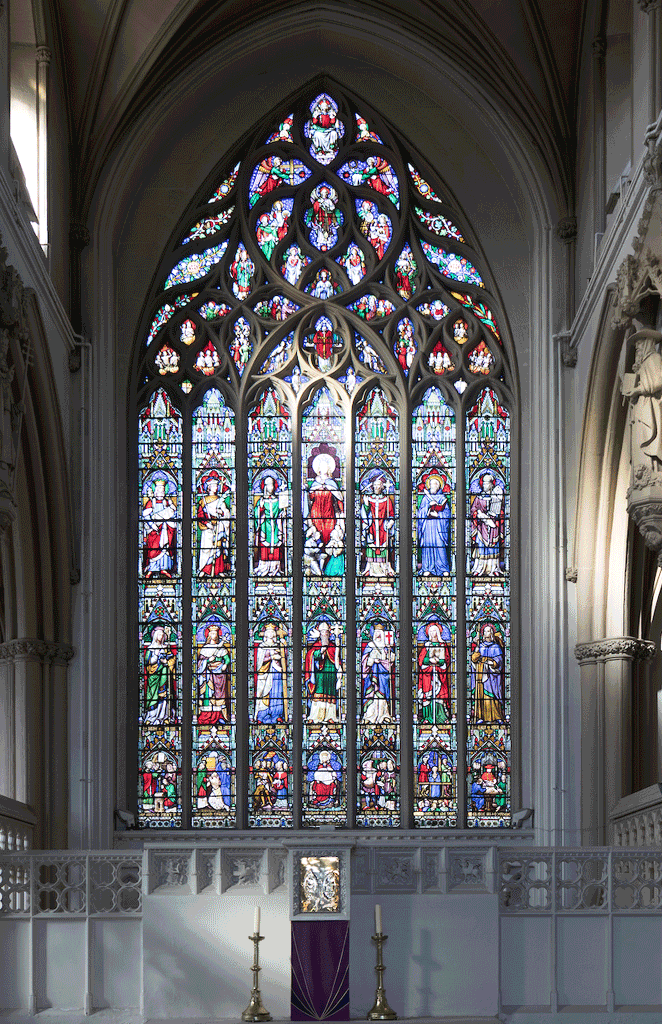
Beneath this are three rows; the upper shows Our Lady Help of Christians, flanked by six of the most significant male Saints to the faith in England; the middle has St Gregory the Great flanked by six of the most significant female Saints to the faith in England; the lower row depicts scenes illustrating the glory of the Church in England from the Conversion of St Ethelbert, King of Kent by St Augustine in 597 through to the Restoration of the Catholic Hierarchy in 1850.
During the Second World War all of the stained glass windows in the Cathedral were removed and placed in storage at Leagram Hall in Chipping, Lancashire, at the time the hall was a religious house run by the Montfort Missionaries. Following the War the east window was restored and returned to its original location, where it has remained ever since, forming a beautiful backdrop to all of the liturgical celebrations held at the cathedral.


